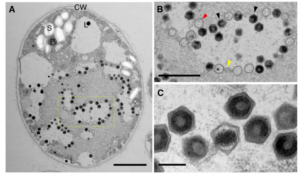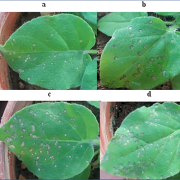The elephant in the genome: Cryptic infection by giant viruses
 Eukaryotic genomes contain many endogenous viral elements (EVEs), which are genetic footprints of past viral infections. With the discovery of Nucleocytoplasmic Large DNA Viruses (NCLDVs), or giant viruses, research has turned to exploring how giant endogenous viral elements (GEVEs) shape host genomes. Giant viruses are prevalent in unicellular green and brown algae, and some species of bryophytes and lycophytes. While viral latency is a well-known strategy in many viral lineages, how giant viruses use latency remains poorly understood. Erazo et al. explored the effect of latency in Chlamydomonas reinhardtii green algae. Using long-read sequencing and qPCR, they discovered active GEVEs in the host genome producing new viruses, without host death. The accumulation of new viruses during the stationary phase of algal growth indicates a cryptic infection strategy. Similar viral elements have also been found in Chlamydomonas and other green algae species field isolates, suggesting that latent infections may be a widespread strategy for giant viruses. This study highlights the importance of investigating GEVEs to uncover a hidden layer of virus-host interactions that has largely gone unnoticed, with potential implications for understanding genome evolution and the broader role of giant viruses in eukaryotic biology.(Summary by Xavier Ozowara [email protected]). Science 10.1126/science.ads6303
Eukaryotic genomes contain many endogenous viral elements (EVEs), which are genetic footprints of past viral infections. With the discovery of Nucleocytoplasmic Large DNA Viruses (NCLDVs), or giant viruses, research has turned to exploring how giant endogenous viral elements (GEVEs) shape host genomes. Giant viruses are prevalent in unicellular green and brown algae, and some species of bryophytes and lycophytes. While viral latency is a well-known strategy in many viral lineages, how giant viruses use latency remains poorly understood. Erazo et al. explored the effect of latency in Chlamydomonas reinhardtii green algae. Using long-read sequencing and qPCR, they discovered active GEVEs in the host genome producing new viruses, without host death. The accumulation of new viruses during the stationary phase of algal growth indicates a cryptic infection strategy. Similar viral elements have also been found in Chlamydomonas and other green algae species field isolates, suggesting that latent infections may be a widespread strategy for giant viruses. This study highlights the importance of investigating GEVEs to uncover a hidden layer of virus-host interactions that has largely gone unnoticed, with potential implications for understanding genome evolution and the broader role of giant viruses in eukaryotic biology.(Summary by Xavier Ozowara [email protected]). Science 10.1126/science.ads6303





